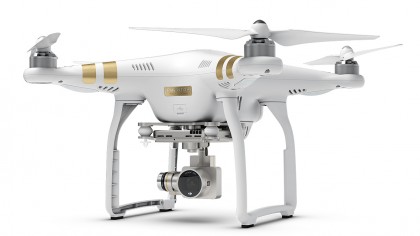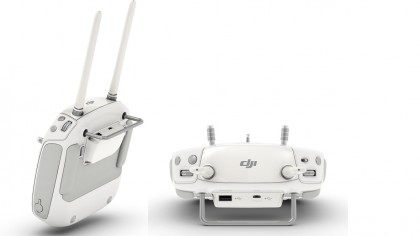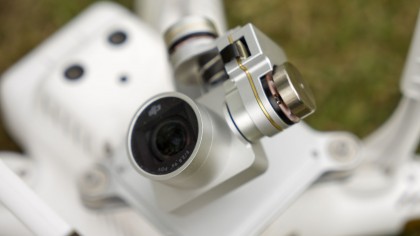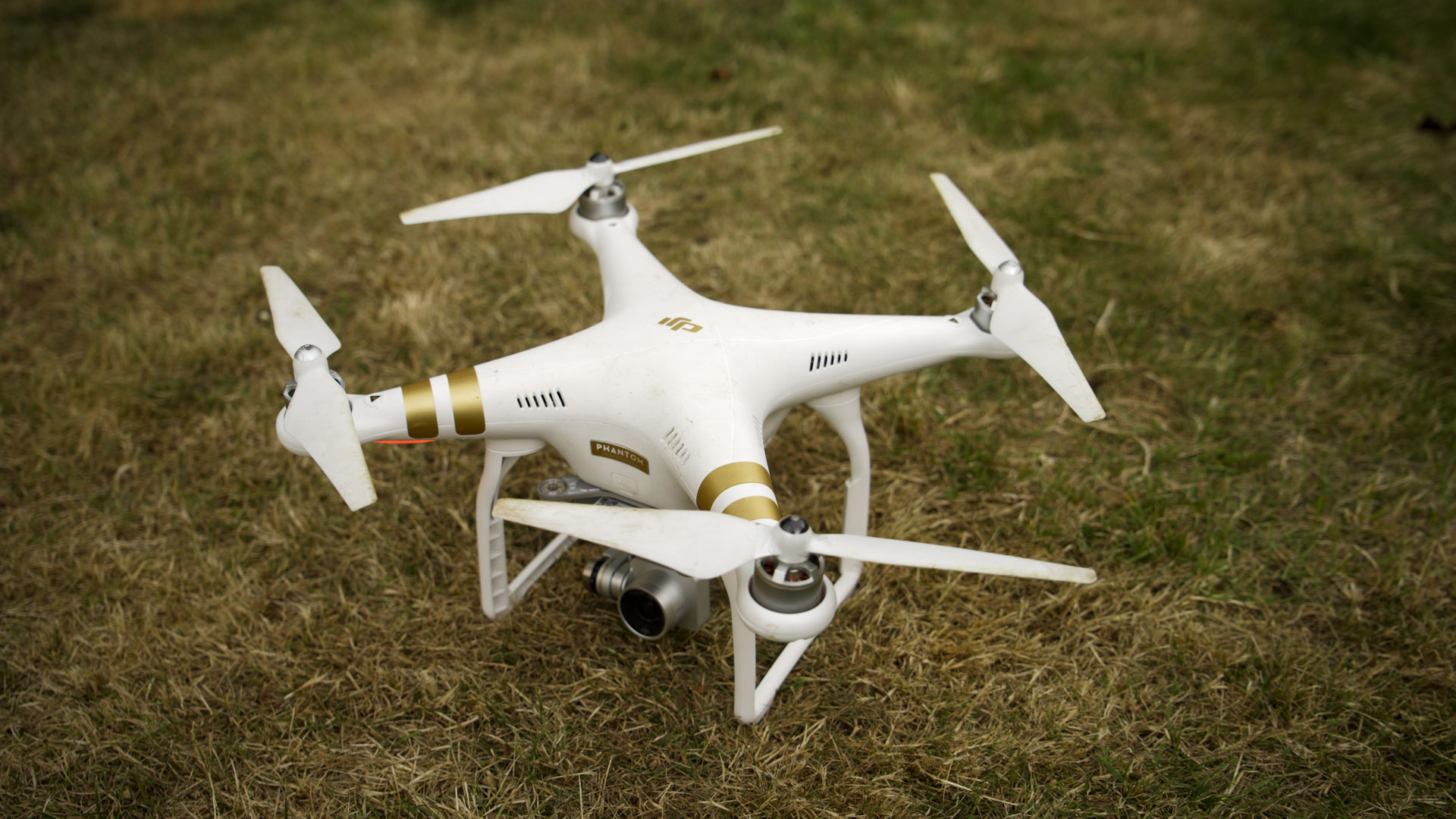TechRadar Verdict
The Phantom 3 Professional is incredibly easy to fly, captures stunning 4K video and features a direct live view link between the camera in the air and your mobile device. There's little not to like in this compact, feature-packed drone.
Pros
- +
Easy flight control
- +
Excellent video quality
- +
Small and lightweight
Cons
- -
Android app is slow
- -
No advanced autopilot
- -
Expensive batteries
Why you can trust TechRadar
Quadcopter and multirotor drones are rapidly growing in popularity, and it's easy to see why. They're relatively simple to operate, and many come equipped with small high-definition cameras, making aerial photographer accessible and affordable – a few years ago you couldn't have captured such footage without hiring a plane or helicopter, or learning to fly a microlight.
The DJI Phantom has become the consumer drone of choice thanks to its affordable price, small size, ease of use and stylish design, and it's available in many high street stores. We took a look at the original Phantom back in 2013, but there have been big advances in drone technology since then, and despite having almost identical looks the latest incarnation the Phantom 3 is a very different beast to the original.
What's new
The Phantom 3 is available in two versions – Professional and Advanced, with the only difference between the two being the camera. The Professional, which we're reviewing here, has a camera capable of shooting 4K movies, whereas the Advanced is limited to Full HD (1080p).
DJI has kept the style of the body visually the same as the Phantom and Phantom 2, but there are some small changes to accommodate the new technology and performance enhancements. These include a new battery, tilted motors, wider landing gear and a smaller remote control handset.

Owners of the Phantom 1 upgrading to the Phantom 2 required new and very different battery packs. The Phantom 3 also sports a new battery pack, which despite looking identical to the Phantom 2's battery is again all new, so if you own spare batteries for a Phantom 2 these won't be compatible with the 3 if you upgrade.
The new pack is rated at 4480mAh at 15.2v, and powers between 15 and 20 minutes of flight depending on how you fly. The new pack is also considerably more expensive, at around £124 (about US$194), as opposed to around £90 (about US$140), which is something to bear in mind as additional batteries are an essential.
The four brushless motors have been reset with a slight tilt to aid stability and smart braking controlled by the new intelligent flight controller. The wider landing gear is also a welcome improvement, and helps to prevent the gear from appearing in footage.
The controller
The remote control handset has gone through a more major overhaul than the drone itself. It has been reduced slightly in size compared to the one that shipped with the Phantom 2, and it features a built-in rechargeable battery rather than using AAs.
On the front of the handset is a line of LEDs that indicate the unit's power level – one charge should last for a good ten or more flights, although it's sensible to charge the unit after each session. On the back is a USB connection for your phone to enable Live View from the camera to the DJI Pilot app, which is a major improvement on the Wi-Fi connection used with the Phantom 2 Vision+ and uses DJI's own Lightbridge technology.

Lightbridge enables iOS or Android devices to connect directly through USB to the Phantom 2.4Ghz handset, and transmits the footage from the camera to the mobile device. This live stream comes through at HD (720p) and has a workable range of up to 1.2 miles, although in our tests using an iPhone 6 we were unable to test this distance in flight.
The handset also features direct control buttons to start and stop recording, take photos, adjust camera settings and tilt the camera; some of these buttons can be customised using the app, but even without the app you'll still have plenty of control over the camera.
Improved app
The DJI Pilot app is the same one used by DJI's prosumer quadcopter, the Inspire 1. It's compatible with iOS and Android devices, gives you access to all of the Phantom 3's settings and features. When you launch the app you're presented with four options: Camera, Director, Store and User Centre.
The Camera section of the app enables you to control the camera to shoot video, take photos, and adjust the gimbal and camera settings such as exposure compensation, shutter speed and sensitivity.
The app's interface is initially a little daunting, with the live view feed surrounded by icons and settings that can be adjusted. It takes a few minutes to check out the basic features that the app offers, and it's well worth familiarising yourself with it before you venture out for a flight.
The app is the window into the Phantom's settings and features, and is roughly split into GPS, Phantom diagnostic, direct control and camera.
Once calibrated, the GPS settings enable the Phantom to pinpoint its location, and has handy features such as the ability to set your location as the home point, so if you lose sight of the Phantom, or more commonly lose all depth perception, you can hit the home button on the interface or handset and the craft will come back to you.
There's also a handy take off button on the interface which helps you to launch if you're new to flying. The interface features a map that can be enlarged and shows the location of the quadcopter.
The app's General settings enable you to configure the customisable buttons, check battery charge and (more importantly) flight time, adjust the gimbal and setup advanced features such as YouTube Live streaming.
The camera
The 4K camera is the big selling point of the Professional, and DJI has really addressed the needs of both the videographer and photographer with the scope of settings and adjustments.
At the heart of this camera is the Sony 1/2.3-inch Exmor sensor, from a sensor family that has already proved itself with many action cameras. The small camera features an f/2.8 lens with a 94 degree field of view, which equates to a 35mm equivalent of 20mm. Unlike an action camera, the Phantom's camera controls distortion well, and avoids the usual fish-eye look that you would associate with the likes of the GoPro Hero4, a camera often used with quadcopters.

This small camera is mounted under the body of the craft and is suspended from a motorised gimbal. Although known for its quadcopters, DJI is also in the camera market, and produces motorised gimbals for the broadcast and the film industry. This expertise is evident in this very small and impressive gimbal.
The job of the gimbal is to keep footage as level and steady as possible, and it does an impressive job. Panning footage is level, and looks like the camera is on runners rather than mounted on a flying craft. Launching the Phantom above the tree line shows the steadiness of the camera, capturing footage that would usually require a telescopic camera pole.
Ali Jennings is the imaging lab manager for Future Publishing's Photography portfolio. Using Imatest Master and DxO Analyser he produces the image quality tests for all new cameras and lenses review in TechRadar's cameras channel. Ali has been shooting digital since the early nineties and joined Future's Photography portfolio back in 2003.
